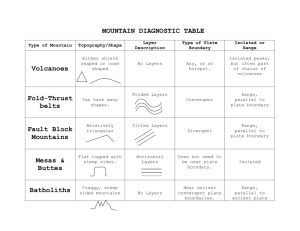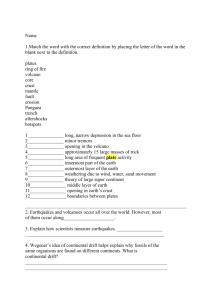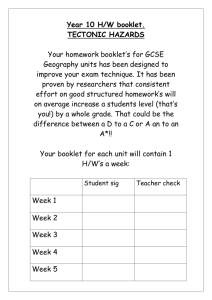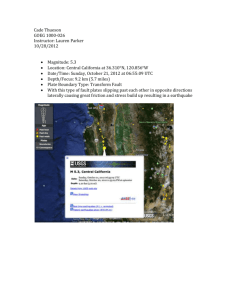Lab #: Plate Boundaries
advertisement
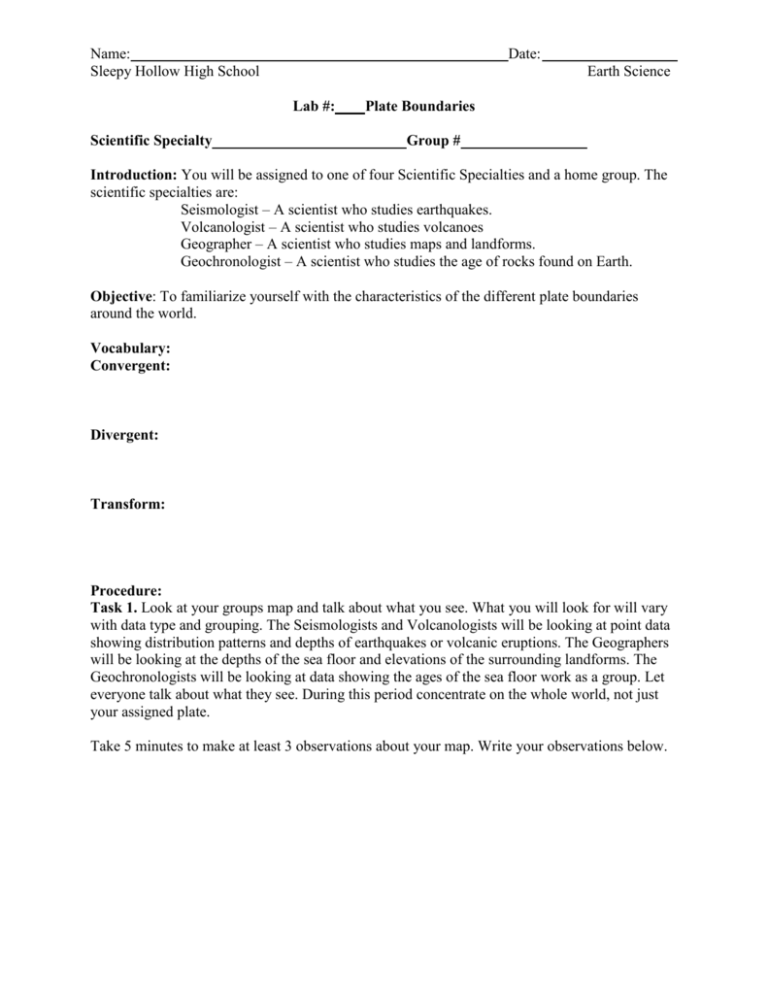
Name: Sleepy Hollow High School Date: Earth Science Lab #: Scientific Specialty Plate Boundaries Group # Introduction: You will be assigned to one of four Scientific Specialties and a home group. The scientific specialties are: Seismologist – A scientist who studies earthquakes. Volcanologist – A scientist who studies volcanoes Geographer – A scientist who studies maps and landforms. Geochronologist – A scientist who studies the age of rocks found on Earth. Objective: To familiarize yourself with the characteristics of the different plate boundaries around the world. Vocabulary: Convergent: Divergent: Transform: Procedure: Task 1. Look at your groups map and talk about what you see. What you will look for will vary with data type and grouping. The Seismologists and Volcanologists will be looking at point data showing distribution patterns and depths of earthquakes or volcanic eruptions. The Geographers will be looking at the depths of the sea floor and elevations of the surrounding landforms. The Geochronologists will be looking at data showing the ages of the sea floor work as a group. Let everyone talk about what they see. During this period concentrate on the whole world, not just your assigned plate. Take 5 minutes to make at least 3 observations about your map. Write your observations below. Task 2. Answer the following questions for each of the boundaries listed below: 1. Mid-Atlantic Ridge. Type of Plate Boundary: a. Describe the depth of the ocean along the Mid-Atlantic Ridge b. Describe the age of the bedrock. c. Describe the volcanic activity. d. Describe the earthquake activity. 2. East Pacific Ridge. Type of Plate Boundary: a. Describe the depth of the ocean along the boundary. b. Describe the age of the bedrock. c. Describe the volcanic activity. d. Describe the earthquake activity. 3. San Andreas Fault. Type of Plate Boundary: a. Describe the depth of the ocean along the boundary. b. Describe the age of the bedrock. c. Describe the volcanic activity. d. Describe the earthquake activity. 4. Nazca and South American Plates. Type of Plate Boundary: a. Describe the depth of the ocean along the boundary. b. Describe the age of the bedrock. c. Describe the volcanic activity. d. Describe the earthquake activity. 5. The Philippines and Pacific Plates. Type of Plate Boundary: a. Describe the depth of the ocean along the boundary. b. Describe the age of the bedrock. c. Describe the volcanic activity. d. Describe the earthquake activity. Conclusion Questions: Answer the following questions in complete sentences. 1. How many types of plate boundaries are there? 2. According to the Earth Science Reference Tables and your maps, where are most divergent plate boundaries found? 3. At which type of plate boundary would a trench (and subduction zone) be found? 4. At which type of plate boundary is new oceanic crust found? 5. What geological feature forms when two continental plates collide?



